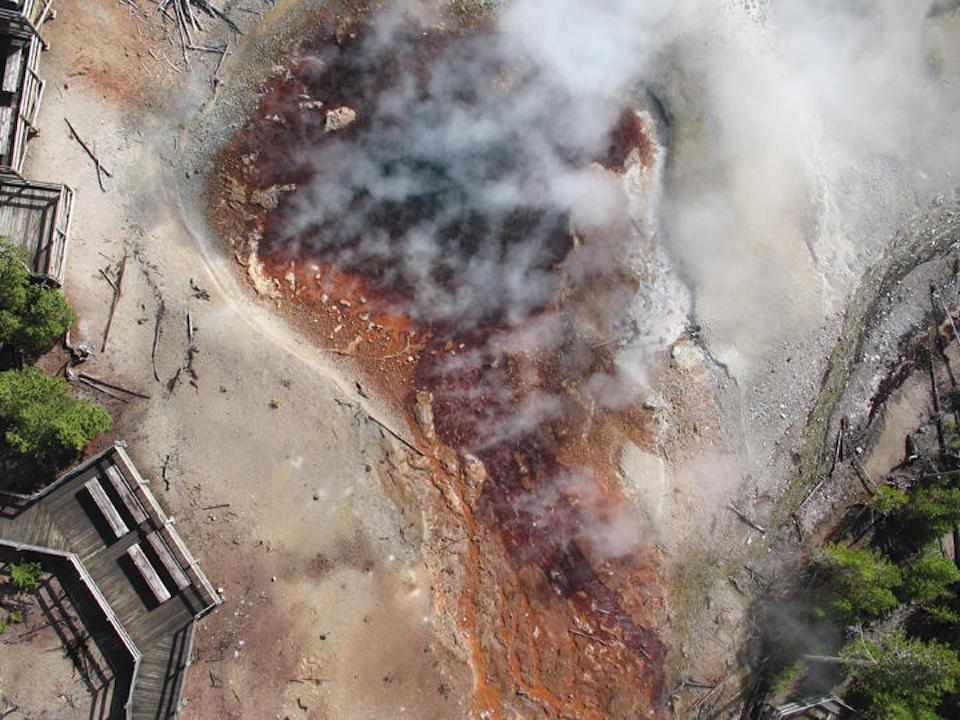
Gases from Yellowstone National Park's thermal features are helping scientists peer back into Earth's early development/Rebecca Latson file
Editor's note: Yellowstone Caldera Chronicles is a weekly column written by scientists and collaborators of the Yellowstone Volcano Observatory. This week's contribution is from Dr. Michael Broadley, postdoctoral researcher at the Université de Lorraine in Nancy, France
With oceans covering over 70 percent of Earth's surface and an atmosphere rich in volatile elements (carbon, nitrogen and oxygen), Earth has seemingly always provided the perfect environment for life to develop in the Solar System. But how and when did these volatiles arrive on the planet? It turns out, the answer lies buried thousands of kilometers deep below Yellowstone National Park.
When our planet formed some 4.5 billion years ago, the Solar System was a very different, chaotic, place. The Earth is thought to have grown from repeated violent collisions between kilometer-sized asteroids that culminated in an impact between the proto-Earth and a Mars-sized planetoid—an impact that resulted in the formation of the Moon.
These impacts would have generated huge amounts of energy that could have melted the entire planet and potentially stripped it of volatile elements, like oxygen, carbon, and nitrogen, leaving it dry and barren of the ingredients essential for life. The general consensus has been that Earth was resupplied with volatile elements following the Moon-forming impact, probably thanks to comets and asteroids originating from the cold outer solar system.
However, now a group of researchers from the Centre de Recherches Pétrographiques et Géochimiques (CRPG, CNRS and Université de Lorraine, Νancy, France), in conjunction with scientists from Woods Hole Oceanographic Institution, Oxford University and the Instituto Nazionale di Geofisica e Vulcanologia, suggest that this idea of late delivery of volatiles to Earth may need to be reexamined.

Aerial view of Echinus Geyser, which exhibits irregular behavior, sometimes erupting regularly for months, and then ceasing altogether. Gas emissions from the geyser are mostly steam and occur whether the geyser is erupting/Brit Graham Wall
In order to travel back through time and glimpse at the chemical composition of the early Earth, the group of scientists headed to Yellowstone National Park to collect gases that are released from the volcanic system there.
“Yellowstone is the ideal location to study Earth’s primordial chemistry, as the volcanic gases released there have a source deep within the planet, providing a view of the most pristine parts of Earth’s interior,” said Dr. Peter Barry, of the Woods Hole Oceanographic Institution
By measuring small quantities of gases such as krypton and xenon, called noble gases, contained within the volcanic output at Yellowstone, the scientists were able to determine the origin of volatiles, such as water, that remain hidden in the deep Earth. This was possible because noble gases are a special group of elements that are not affected by chemical and biological processes, unlike other elements like carbon. Noble gases can therefore act as a sort of fingerprint that allow us to pinpoint where the volatiles on Earth originated from, even after 4.5 billion years of Earth's history.
The team found that the mantle beneath Yellowstone retains krypton and xenon "fingerprints" that closely match that of meteorites. But perhaps most importantly, by taking advantage of the characteristics of the xenon, the authors of this study were able to show that noble gases contained within the Yellowstone mantle source have remained isolated deep in the mantle for the majority of Earth's history.
Professor Bernard Marty, from Université de Lorraine and co-author of the study, explained further: "Xenon has nine different isotopes, or ‘flavors,’ but one specific isotope, xenon-129, holds the key to understanding the timing of volatile delivery to Earth."
Xenon-129 is unique, as it forms from the radioactive decay of iodine-129, which has a very short half-life. This means that after the first 100 million years of Earth's history, all of the iodine-129 had transformed to xenon-129, and the amount of xenon-129 was locked in place. The authors showed that the amount of xenon-129 in the Yellowstone mantle source is different from other volcanoes that sample the mantle closer to the Earth's surface, and therefore mixing between the deep mantle and material arriving late on the Earth's surface must have been limited. This study therefore suggests that the Earth kept its volatile elements despite its violent upbringing, and that a "lucky" late delivery of comets and asteroids may not be required to explain the origin of life.
The research team is planning future field campaigns to Yellowstone to further investigate how the Earth obtained its volatiles and became the habitable planet we know today.
We have only just begun to scratch the surface of the different secrets to Earth's formation hidden in the deep mantle!
(This study was supported by the European Research Council, the Deep Carbon Observatory and the Sloan Foundation.)




 Support Essential Coverage of Essential Places
Support Essential Coverage of Essential Places






